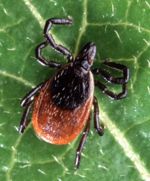Arachnid Flashcards
Jump to navigation
Jump to search
|
|
Arachnids
| Question | Answer | Article |
|---|---|---|
| What are the two divisions of the arachnid body? |
|
Link to Answer Article |
| Summarise the arachnid life cycle |
|
Link to Answer Article |
Ticks
| Question | Answer | Article |
|---|---|---|
| What are seed ticks? |
|
Link to Answer Article |
| How can you differentiate hard ticks from soft ticks? |
|
Link to Answer Article |
| True or False: Soft ticks can swell up to three times their body size whilst taking a blood meal |
|
Link to Answer Article |
| List the mouthparts of ticks |
|
Link to Answer Article |
| Fill in the missing words about soft and hard ticks | Soft ticks feed little and often and on many hosts. Hard ticks take one blood meal at each life cycle stage and can feed on one, two or three different hosts during their life cycle. | Link to Answer Article |
| What is trans-ovarian transmission and give an example of a species of tick which uses this |
|
Link to Answer Article |
| What is trans-stadial transmission? |
|
Link to Answer Article |
| What is the most important tick species in the UK, how many hosts does it feed upon and what disease can it spread? |
|
Link to Answer Article |
| What climate does Rhipicephalus species prefer and what is it a vector for? |
|
Link to Answer Article |
| Name some important soft ticks |
|
Link to Answer Article |
| What are the main methods of tick control? |
|
Link to Answer Article |
Mites
| Question | Answer | Article |
|---|---|---|
| How many pairs of legs do adult and nymph mites have respectively? |
|
Link to Answer Article |
| What is the main feature which distinguishes burrowing mites from non-burrowing mites? |
|
Link to Answer Article |
| Is Sarcoptes as burrowing or non-burrowing mite? |
|
Link to Answer Article |
| What clinical signs present in an infection caused by Sarcoptes mites? |
|
Link to Answer Article |
| Which species are affected by Knemidocoptes mites? |
|
Link to Answer Article |
| What are the three main species of Knemidocoptes mites and what conditions do they cause? |
|
Link to Answer Article |
| Which species do Trixacarus mites affect and how long can it take before the infection causes death? |
|
Link to Answer Article |
| What shape are Demodex mites? |
|
Link to Answer Article |
| What are the two types of demodecosis caused by Demodex mites? |
|
Link to Answer Article |
| What species do Notoedres mites affect? |
|
Link to Answer Article |
| What are the main species of non-burrowing mites of veterinary importance? |
|
Link to Answer Article |
| Do Psoroptes mites have segmented or unsegmented pedicles? |
|
Link to Answer Article |
| What are the two main Psoroptes mites of veterinary importance? |
|
Link to Answer Article |
| Do Chorioptes mites have segmented or unsegmented pedicles and what is the main species of veterinary importance? |
|
Link to Answer Article |
| Which non-burrowing mite causes otitis externa in dogs? |
|
Link to Answer Article |
| Which non-burrowing mite causes walking dandruff? |
|
Link to Answer Article |
| What is Dermanyssus gallinae better known as and does it spend most of its time on or off its host species? |
|
Link to Answer Article |
| Which mites are often found in feed stores and bedding and what problems do they cause? |
|
Link to Answer Article |
| To which industry do Varroa destructor pose a major problem? |
|
Link to Answer Article |
